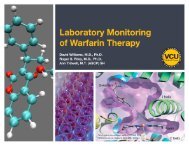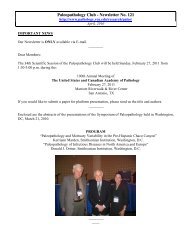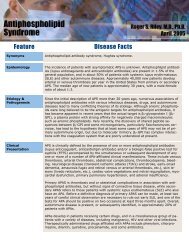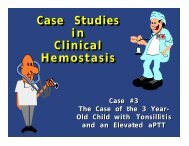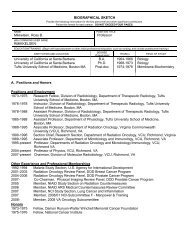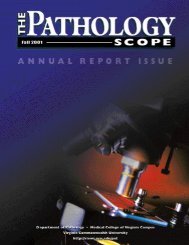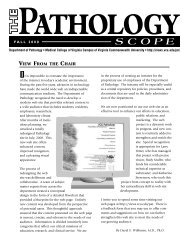D-Dimer Assays - Pathology
D-Dimer Assays - Pathology
D-Dimer Assays - Pathology
You also want an ePaper? Increase the reach of your titles
YUMPU automatically turns print PDFs into web optimized ePapers that Google loves.
D-<strong>Dimer</strong> <strong>Assays</strong> 2<br />
Test<br />
Methodology<br />
says are inexpensive and rapid to perform, numerous studies have shown that they<br />
lack the sensitivity to detect D-dimers in critical clinical situations, particularly in the<br />
detection of pulmonary embolism and acute venous thrombosis.<br />
Immunoturbidometric assays are automated microparticle assays in which a beam of<br />
monochromatic light is passed through a suspension of latex microparticles coated by<br />
covalent bonding with monoclonal antibodies specific for D-dimer. The wavelength of<br />
the light (540 nm) is greater than the diameter of the latex microparticles and so the<br />
solution of latex microparticles only slightly absorbs the light. When the plasma is<br />
added to the suspension, any D-dimer present in the sample causes the latex microparticles<br />
to agglutinate, becoming aggregates with diameters greater than the wavelength<br />
of the light. This increases the absorbance of the light, which is measured photometrically,<br />
and proportional to the amount of D-dimer present in the test sample.<br />
These assays are cost effective, relatively rapid to perform, and have a sensitivity<br />
comparable to conventional ELISA.<br />
A commercially available whole blood assay for D-dimer uses a bispecific antibody specific<br />
for D-dimer and a red blood cell antigen. A drop of whole blood is incubated with<br />
the monoclonal antibody solution, causing visible agglutination of the red cells if D-<br />
dimers are present. Many reports have indicated a high sensitivity for the assay, and it<br />
is widely used in clinical settings.<br />
Normal Values and<br />
Critical Limits<br />
The reporting standard for D-dimers varies with the test methodology and reagent<br />
manufacturer. Latex and whole blood agglutination results are usually reported<br />
as a D-dimer range (ng/mL). ELISA and immunoturbidimetric assays are<br />
usually reported in fibrinogen equivalent units (FEU). One FEU is the quantity of<br />
fibrinogen that was initially present before it was broken down. The actual<br />
quantity of D-dimer is approximately half of an FEU (when 1.0 of fibrinogen g/<br />
mL is broken down, 0.5 g/mL of D-<strong>Dimer</strong> remain).<br />
Interferences<br />
Rheumatoid factor may cause a false positive D-dimer assay. Lipemia may interfere<br />
with immunoturbidimetric and ELISA assays.<br />
Clinical Utilization<br />
XDPs are cross-linked fibrin degradation products which arise directly from fibrin.<br />
Thus, the measurement of XDPs, unlike total FDPs, is a specific measure of fibrinolysis.<br />
Elevated D dimers are seen in DIC, pulmonary embolism, arterial and venous<br />
thrombosis, septicemia, cirrhosis, carcinoma, sickle cell crisis, and following operative<br />
procedures. Both FDPs and XDPs are present during late pregnancy and for approximately<br />
48 hours post-surgery. During fibrinolytic therapy the FDP test is positive, while<br />
the D-dimer test is negative in the absence of thrombolysis.<br />
Disseminated intravascular coagulation (DIC, consumption coagulopathy) is one of the<br />
most common and clinically important acquired disorders of hemostasis. In DIC, intravascular<br />
activation of the coagulation system results in the widespread deposition of<br />
fibrin microthrombi in the microcirculation, the consumption of platelets and clotting<br />
factors, and activation of the fibrinolytic system. At the same time that thrombin converts<br />
fibrinogen to fibrin, it also activated Factor XIII to form a plasma transglutaminase,<br />
Factor XIIIa, which stabilizes fibrin by cross-linking the gamma chains of fibrinogen<br />
in the region of the D-domain. Plasmin digests fibrin and fibrinogen to produce<br />
fibrin(ogen) degradation (FDP) (or split, FSP) products (X,Y,D, and E), which are removed<br />
from the circulation by the reticuloendothelial system.



